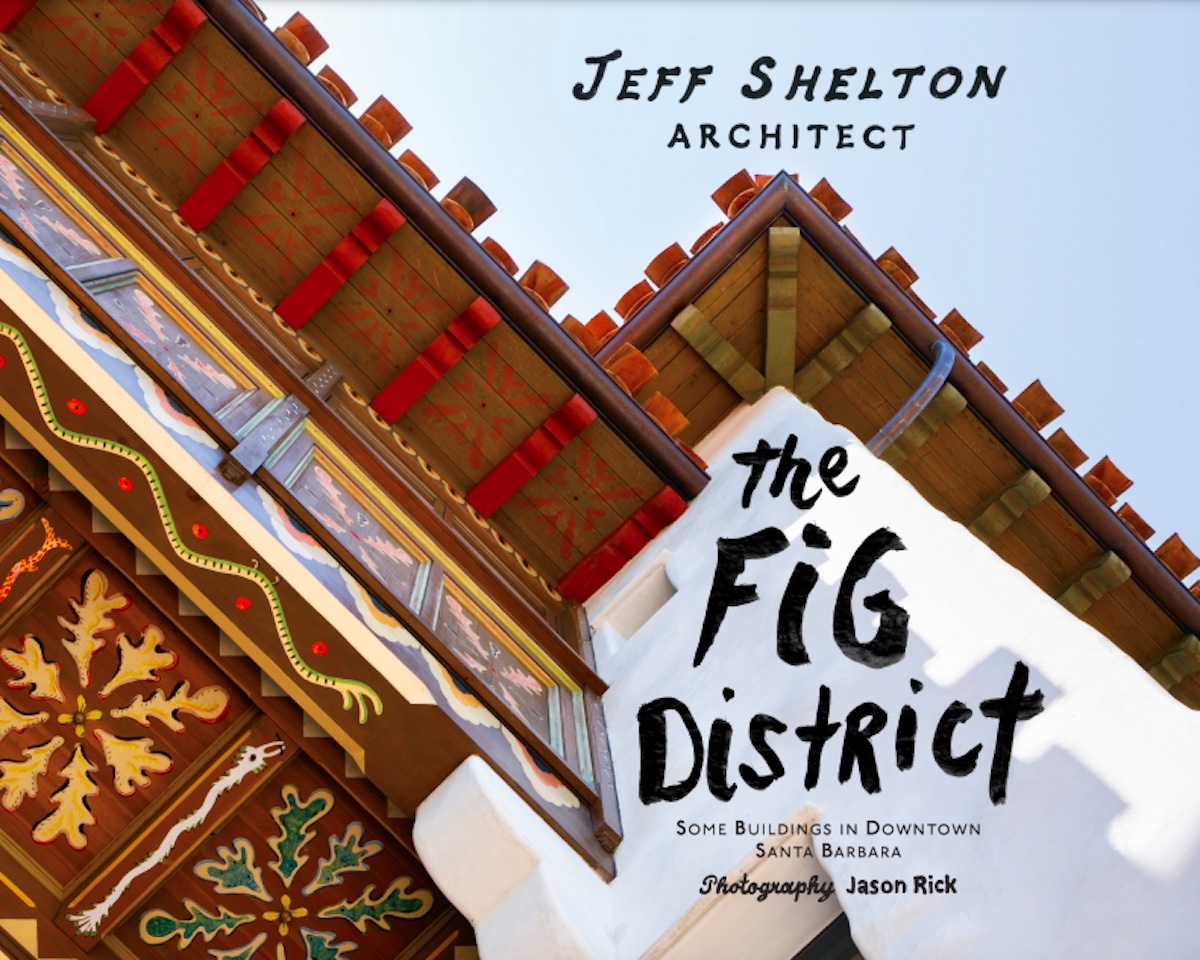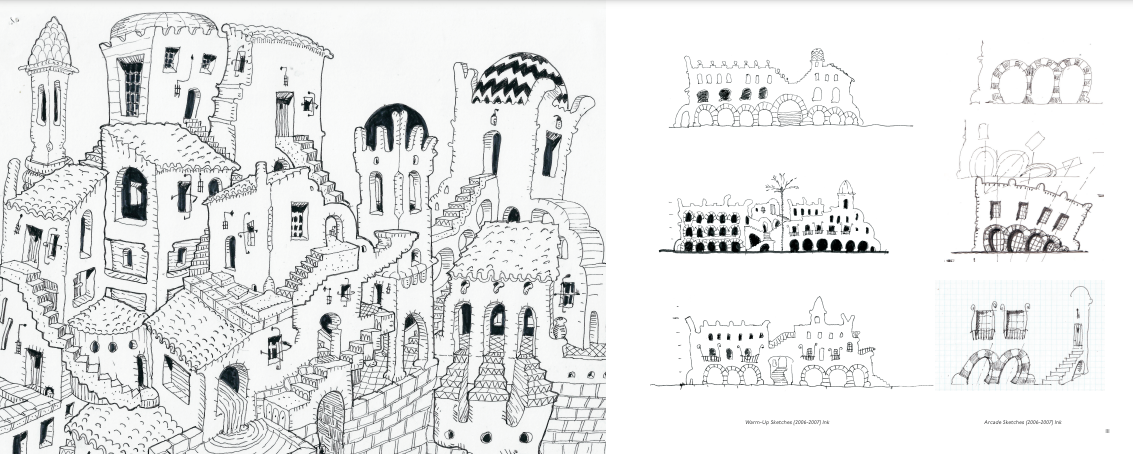Jeff Shelton Gets Big on Fig with New Design Book

If you’ve lived in Santa Barbara long enough, you know exactly who Jeff Shelton is. If you don’t recognize his name, you’ve certainly seen his work. For years, architect Jeff Shelton, this resident president of delightful buildings, has been lighting up the streets of Santa Barbara with smile-inducing structures that push the boundaries of architectural possibility. A book is now available for folks who want to dive deeper into the design process and have a little of this architecture in their own home. The Fig District is a 192-page project (spearheaded by Mattie Shelton of Shelton Huts — who also happens to be Jeff’s daughter) featuring a handful of Jeff’s buildings that are within walking distance of his downtown S.B. office. I recently caught up with Jeff over email for a sneak peek into the process of creating this new book.
When did the idea for The Fig District start marinating in your brain, and what was the process of creating it like?
Marinating! Sounds peaceful and intentional. The Fig District is what we started calling the area within about six blocks of my office on Fig Avenue. I’ve been lucky enough to have designed several buildings close enough to walk to when I want to get away from the desk or just take a coffee break. They all have a similar context, on commercial lots in a city with a “Spanish Revival” design overlay. Upton Construction has built all of them, and in some way, they are a part of the same architectural language. When people started calling to ask where these buildings were located, I would send them a typed list. One night, I drew up a map and put it on a card, which made it easier; I could just hand out the card. Then I started giving tours for fundraisers, telling odd stories about the approval or design of each building, and I decided to make a “pamphlet” that I could hand out. When my family and I went to Montesquieu-Volvestre in southwestern France for three months, I started the so-called pamphlet while sitting at the Bar des Arcades.
The process of making The Fig District was more difficult than designing a building. A building is instinctual, reacting along the way. The book made me dive into some of the convoluted design processes and the morass of the relationships with the city and all involved. Inanimate building materials are easier to work with than words. Luckily, my daughter Mattie took charge and designed a book that exposes the complexities in the design and construction of a building. The process also made it clear that a short pamphlet couldn’t include some of the important stories and people that make a building come alive. The pamphlet became a book.

What was your inspiration for the book?
My inspiration was to make sure people understood that the architect is just one of the pieces to making a building work. A lot of things need to go right, or at least they need to go in a direction we can manipulate. Without Dan Upton and Leon Olson taking a chance, then rolling with some odd ideas, this all goes in a different direction. Without Upton’s sideways thinking about opportunities, the exciting idea doesn’t happen. Without David Shelton’s warped sense of what steel is, this all takes a different turn. Without the city approving these ideas, they stay on paper. I could go on, but that is what the book is for.
A handful of downtown S.B. buildings are featured. What were some of your early experiences building here?
One advantage of building on commercial property is that neighbors don’t complain. When neighbors complain, projects cost more, everyone gets frustrated, and the project gets watered down to a beige version of life. There are construction problems for sure, as there are always tight spaces and big coordination issues. However, this is a great city to build in. If you have an issue, you can go right to the source at the building department and come up with a solution. There may be a lot of regulations, but that is why we live here; we have to deal with it.
The review boards have been kind to me. I make sure that I think things through, and I fill my trash can with ideas that don’t work. By the time I have plans in front of the review board, the building is in my blood, and I bring in a lot of details. I think they recognize that. While I go a bit too far for some, better to go a bit far than fall short.

Who figures out how to build your architectural creations? I heard it is a Merry Band of Artisans.
I somehow find great clients; without them, none of this happens. I start the ball rolling by understanding all the site and ordinance restraints while folding in our client’s needs. I tell them I will try to get them what they want, but they also need to give back to the street and the city’s fabric. Depending on the type of structure we come up with, I meet with Upton Construction and we talk about methods. We meet with the structural engineer early on and try to make sure we are all looking at this the same way. We work our way through the review boards and put together the best set of plans we can. Just because we have plans for a building doesn’t mean it is easy to build. Upton keeps the project in perspective, so we have the opportunity to use the experience of his workers to keep adding touches as we go. After a while, the building takes over, and I answer what the building needs. I tell everyone that the building is talking now. Jason Rick, a client and the book’s photographer, was describing the whole construction experience in an interview. He said, “First, the bulldozers come and grade the site, then the ‘Merry Band of Artisans’ shows up.” Upton has a great crew of people who know what to do, and they work with people like my brother David and Andy Johnson, who have their own way of doing things. When they are on the project, it will always turn out great. David will make it as good as it could possibly get, every time. Andy doesn’t want to discuss money; you can’t bring the word up. This is hard to explain to new clients. It’s kind of tricky. At the end of a project, Andy once brought me an invoice that was written in pencil on a 2×4. You’ve got to remember that the end product is always worth it.
The Fig District is currently on preorder at jeffsheltonarchitect.com and will be available for purchase in November at Santa Barbara Company and local bookstores.
Support the Santa Barbara Independent through a long-term or a single contribution.




You must be logged in to post a comment.